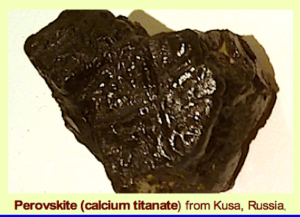Home / Perovskite – calcium titanate +
A promising new way of making high-efficiency
solar cells, using perovskites instead of silicon
A Perovskite mineral (calcium titanate) from Kusa, Russia, taken at the Harvard Museum of Natural History. Perovskites are a wide range of materials with the same type of crystal structure as calcium titanium oxide and could usher in a “new era for low-cost, high-efficiency” solar cells
By Jeffrey Carbeck
Three years ago, Oxford University physicist Henry Snaith, one of the earliest researchers of perovskite, said that material would usher in a “new era for low-cost, high-efficiency” solar cells. This year, it’s one of the World Economic Forum’s top 10 emerging technologies. Jeffrey Carbeck, a specialist leader in advanced materials with Deloitte, discusses the strengths that perovskite may have over silicon photovoltaic cells for solar use.
The silicon solar cells that currently dominate the world market suffer from three fundamental limitations. A promising new way of making high-efficiency solar cells, using perovskites instead of silicon, could address all three at once and supercharge the production of electricity from sunlight.
The first major limitation of silicon photovoltaic (PV) cells is that they are made from a material that is rarely found in nature in the pure, elemental form needed. While there is no shortage of silicon in the form of silicon dioxide (beach sand), it takes tremendous amounts of energy to get rid of the oxygen attached to it. Typically, manufacturers melt silicon dioxide at 1,500 to 2,000 degrees Celsius in an electrode arc furnace. The energy needed to run such furnaces sets a fundamental lower limit on the production cost of silicon PV cells and also adds to the emissions of greenhouse gases from their manufacture.
Perovskites—a wide-ranging class of materials in which organic molecules, made mostly of carbon and hydrogen, bind with a metal such as lead and a halogen such as chlorine in a three-dimensional crystal lattice—can be made much more cheaply and with fewer emissions. Manufacturers can mix up batches of liquid solutions and then deposit the perovskites as thin films on surfaces of virtually any shape, no furnace needed. The film itself weighs very little.
Those features thus eliminate the second big limitation of silicon solar cells, which is their rigidity and weight. Silicon PV cells work best when they are flat and housed in large, heavy panels. But those panels make large-scale installations very expensive, which is in part why you typically see them on rooftops and big solar “farms.”
The third major limitation of conventional solar cells is their power conversion efficiency, which has been stuck at 25 percent for 15 years. When they were first described, perovskites offered much lower efficiency. In 2009, perovskite cells made of lead, iodide and methylammonium converted less than 4 percent of the sunlight that hit them into electricity. But the pace of improvement in perovskites has been phenomenal, thanks in part to the fact that thousands of different chemical compositions are possible within this class of material. By 2016, perovskite solar-cell efficiencies were above 20 percent—a five-fold improvement in just seven years and a stunning doubling in efficiency within just the past two years. They are now commercially competitive with silicon PV cells, and the efficiency limits of perovskites could be far higher still. Whereas silicon PV technology is now mature, perovskite PVs continue to improve rapidly.
Researchers still need to answer some important questions about perovskites, such as how durable they will be when exposed to years of weathering and how to industrialize their production to churn out quantities large enough to compete with silicon wafers in the global market. But even a relatively small initial supply of these new cells could be important in bringing solar power to remote locations that are not yet connected to any electrical grid. When paired with emerging battery technology, perovskite solar cells could help transform the lives of 1.2 billion people who currently lack reliable electricity.
Jeffrey Carbeck is Specialist Leader in Advanced Materials and Manufacturing, DC Innovations, with Deloitte.
. . . . . . . . . . . . . . . . . .
Solar power has big limitations. This wonder material could change that
You might not have heard of them, but these new materials will change the world
Your robot personal assistant will know when you’re stressed, tired or hungry


 Photo: La203 | Wikipedia
Photo: La203 | Wikipedia

